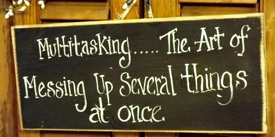

Multitasking Muddle - Stumbling through the Dataverse
Monday, June 2, 2014
Isn't amazing how much we can tell about a person by listening to them speak over the phone?
For example, I can tell if a call center agent is from the Philippines, India, or Canada, and often from different parts of the United States.
I can tell when an attendee is multitasking during a online presentation, when my adult children are texting while I'm on a call with them, and when call center agents are slogging through multi-dimensional CRM data-verses while I'm pouring out my heart to them.
It's as if agents hope to understand who I am, and what I might want, while ignoring what I'm saying.
There has been a dramatic increase in the frequency of me telling someone "No that's not what I'm asking about" or "Let me repeat what I just said, because you don't seem to understand"
Human's can't Multitask
-
"People can't multitask very well, and when people say they can, they're deluding themselves," said neuroscientist Earl Miller. And, he said, "The brain is very good at deluding itself."
-
Miller, a Picower professor of neuroscience at MIT, says that for the most part, we simply can't focus on more than one thing at a time.
-
What we can do, he said, is shift our focus from one thing to the next with astonishing speed.
-
"Switching from task to task, you think you're actually paying attention to everything around you at the same time. But you're actually not," Miller said.
-
"You're not paying attention to one or two things simultaneously, but switching between them very rapidly."
-
Miller said there are several reasons the brain has to switch among tasks. One is that similar tasks compete to use the same part of the brain.
-
"Think about writing an e-mail and talking on the phone at the same time. Those things are nearly impossible to do at the same time," he said..
-
Source: http://www.npr.org/templates/story/story.php?storyId=95256794
'Divide and Conquer'
To be effective, agents need to divide interactions into a set of sequential tasks. When input and output streams commingle, babble results.
Here's an example of a structure that separates and succeeds:
-
1.Listen to what the caller is saying.
-
2.Confirm your understanding by summarizing what was said.
-
3.Access online and supervisory resources after asking permission and informing the caller what's going on.
-
4.Report back on what was found and make recommendations.
-
5.Confirm acceptance of the recommendation.
Call Intelligence Inc. is a Transactional Intelligence and Design Consultancy with over 24 years helping our clients to better understand and improve the outcomes of interactions with their prospects and customers.
Our analyses allow us to map, correlate and prioritize thousands of possible relationships between marketing programs, call handling systems, calls, callers, concerns, agents, competition, etc. and outcomes
